You may not find this terribly rewarding unless you're included here, so this is a good time for casual and random browsers to turn back before they get too caught up in the sweep and majesty of the proceedings and can't let go.

We've down from our mountain aerie in Montegiardino to see coastal Rimini, 16 December 2017, and of course it's raining again, or still raining.

We've parked not far from the railway station and are walking up into the historic centre along Via Dante Alighieri, soon to become the Via IV Novembre (a name celebrating the end of the Battle of Vittorio Veneto in 1918, and therefore the end of World War One on the Italian front).

The site of Rimini was of interest to the Etruscans and later to the Celts and the Umbri, but the Romans founded a colonia called Ariminum here in 268 BC. It became a crossroads for several major Roman roads, including the Via Flaminia and Via Aemilia, and a strategic staging area for the Roman conquest of the Po valley and northern Italy generally. When Julius Caesar brought his legions illegally into Roman home territory, in 49 BC, it was probably in the forum here that he whipped up his men's enthusiasm for the civil war to come (A. Goldsworthy, Caesar, pp 385-87). Remains of the Roman city abound in Rimini to this day.

Rimini was frequently a centre of unwelcome attention during the last days of the western Roman Empire, but remained prosperous as one of the Duchy of the Pentapolis (five Byzantine cities on the Adriatic coast) under the Exarchate of Ravenna in the 6th to 8th centuries. Following which, the Franks under Pepin and later Charlemagne donated Rimini to the papal 'patrimony of St Peter'.
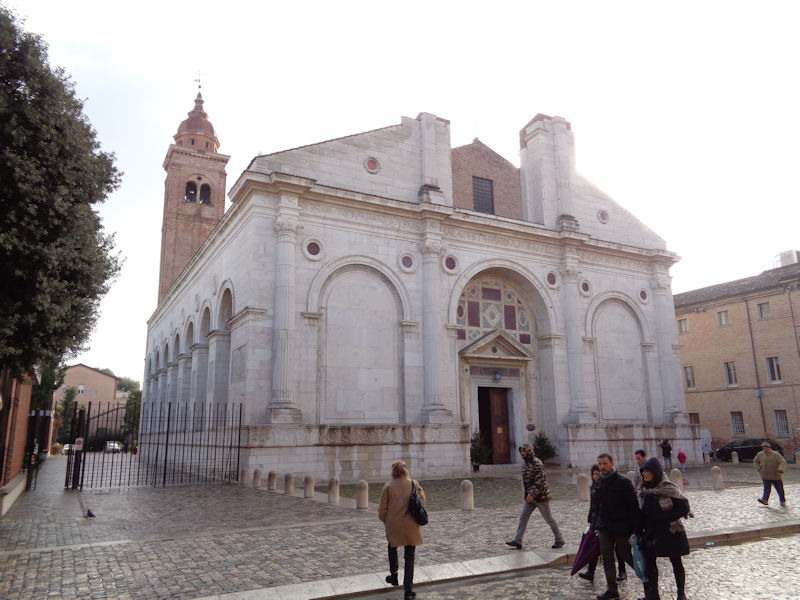
Much of Rimini's history, however, from the 13th to the 16th century, was spent under the dominance of the family of the Malatesta, and it was the famous mercenary commander and lord of Rimini Sigismondo Pandolfo Malatesta who in 1450 commissioned Leon Battista Alberti to redesign the existing 13th century Gothic church of San Francesco, now called the Tempio Malatestiano, or Malatesta Temple.

The work was never completed -- the dome was never built and the top of the façade is still showing the old Franciscan structure within -- because Sigismondo began to run out of funds in 1460 when he was excommunicated in Pope Pius II's vendetta against him and the Malatestas' longtime enemies of the Montefeltro family were closing in on him.

We've arrived just in time to be hurried back out again by church staff anxious to get to their lunches.

Anyway, that's the tomb of Sigismondo's long-time mistress and eventual wife, the local girl Isotta degli Atti (he'd already buried two wives, an Este and a Sforza, who have their own chapel farther down the line), who outlived Sigismondo and briefly governed Rimini as regent for their son Sallustio.

But if we want to take time to contemplate Lord Sigismondo's tomb and his fresco portrait by Piero della Francesca, we'll have to come back either late this afternoon or another day.
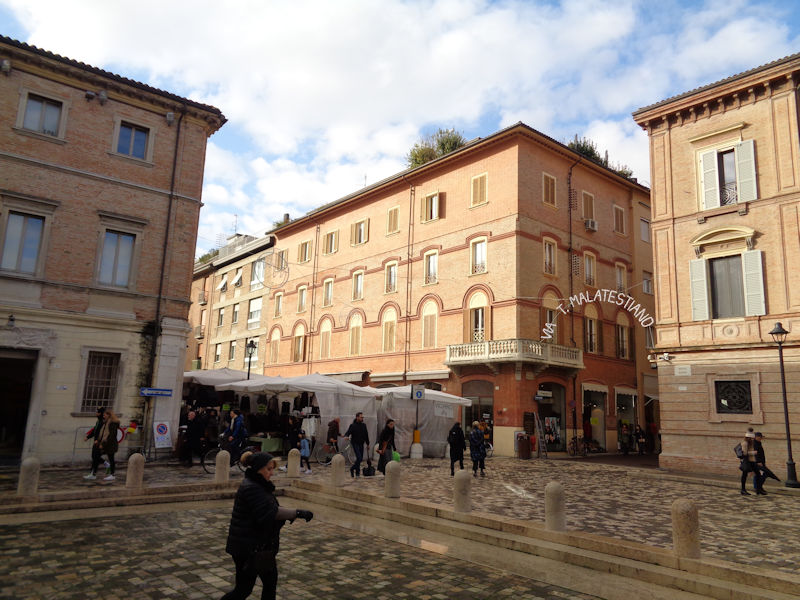
The piazza outside the church, at the intersection of the Via IV Novembre and Via Tempio Malestiano

The Tempio Malestiniano again, a cathedral since 1809, with its Franciscan predecessor peeking out above (and through the arcades along the side). We'll come back soon.

Via IV Novembre, umbrellas up

The Piazza Tre Martiri, the central square and originally the site of the Roman Forum . . .
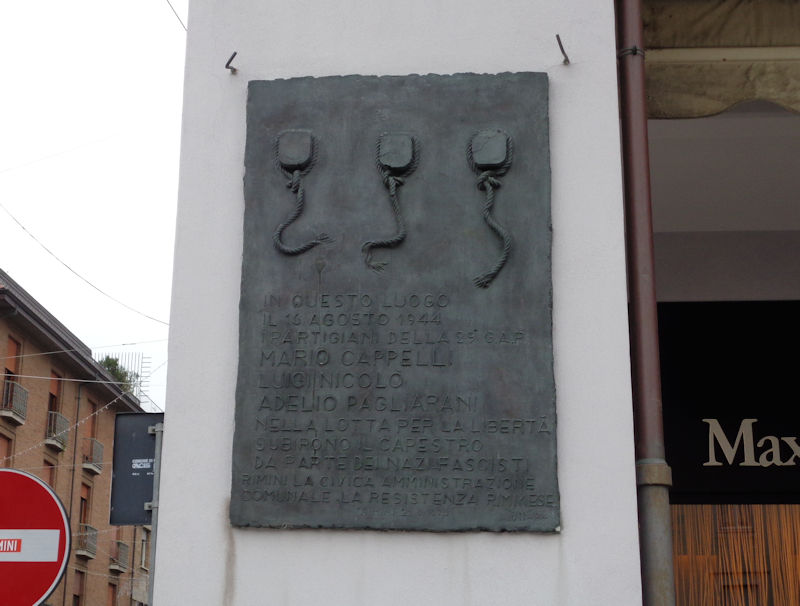
. . . and here is the tasteful memorial to the Three Martyrs, hanged in this square on 16 August 1944 by the Nazi Fascist Party.

The Piazza Tre Martiri is at the intersection between the main streets of the Roman city grid, the cardo we've just walked along and the perpendicular decumanus maximus.

You are here.

Fun for the kids
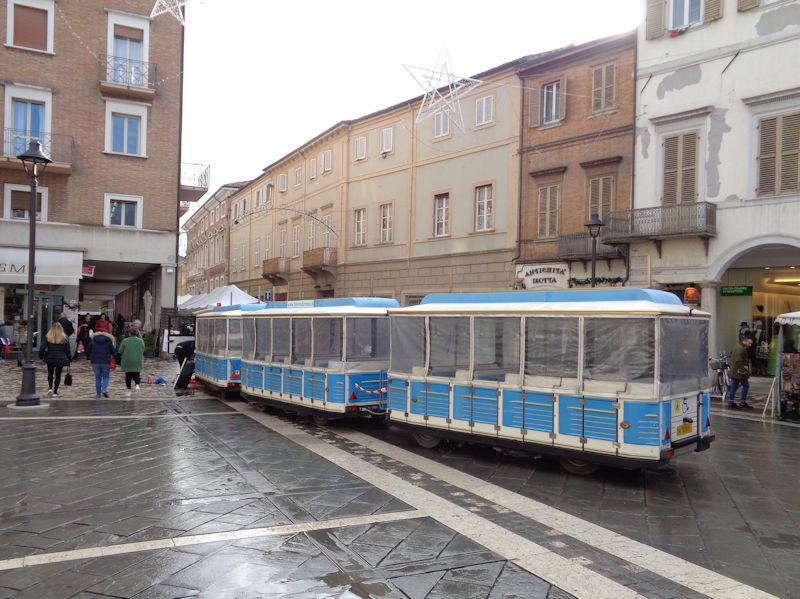
We collect photos of European city tourist trains, with or without their rain flaps down.


An Italian Dotto road train, Sirius model

Along the Corso d'Augusto, the Roman decumanus maximus thoroughfare

That little octagonal chapel is the Tempietto di Sant'Antonio, built in 1518 and restored after an earthquake in 1672, and behind it is the associated 'Chiesa Dei Paolotti' of the Friars Minor of St Francis of Paola, rebuilt after the baroque original was destroyed in World War Two.

The chapel is dedicated to St Anthony of Padua, a 13th century Portuguese Franciscan known for his thorough knowledge of the scriptures and his devotion to the sick and poor, patron saint of Lisbon, lost items, lost souls, and oppressed people, who fetched up somehow at the hermitage of San Paolo near Forlì, near here, where St Francis of Assisi himself was impressed by his preaching. He became a famous preacher, later based in Padua, and after he died in 1231 of "St Anthony's Fire" (i.e., ergotism), he was canonized as a saint in less than a year.
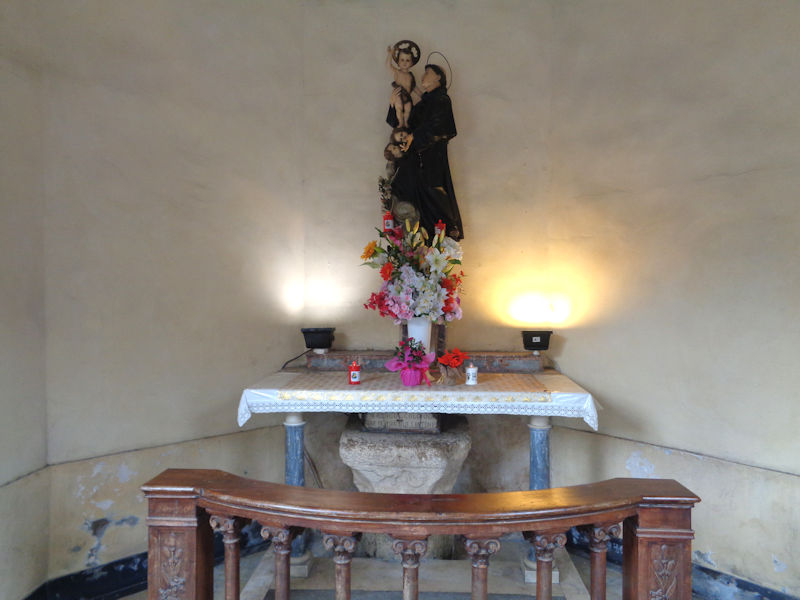
That, presumably, is St Anthony of Padua (whose real name was Fernando Martins de Bulhões).
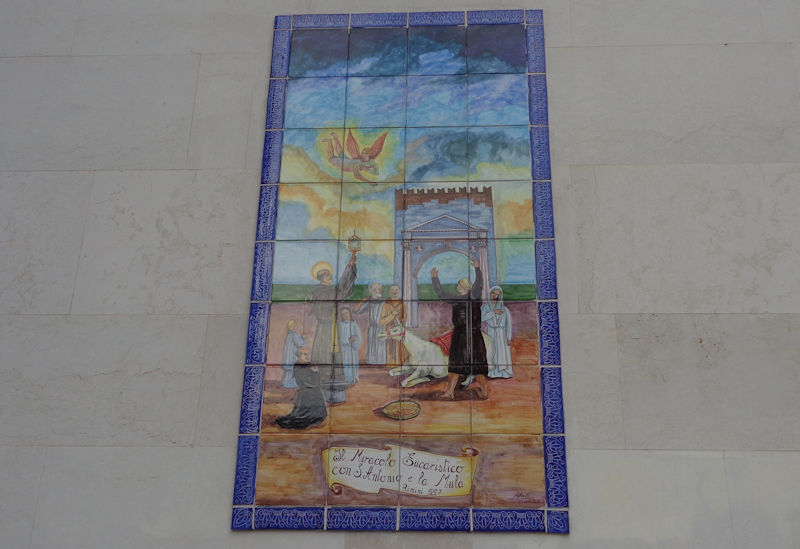
This is one of two illustrations on the front of the church commemorating a few of his main miracles (in addition to the fact that, though the inspired preacher's body decomposed in its tomb over time, his tongue didn't).
In this one, the Miracle of the Mule, St Anthony, having just preached an amazing outdoor sermon to the faithful, was administering the eucharist to the crowd when an unbeliever walked by leading his mule; the mule miraculously sat down in front of the saint and would not budge. That is said to have happened right on this spot. In his second noteworthy achievement in Rimini, he is said to have 'performed a miracle by preaching to fishes'.
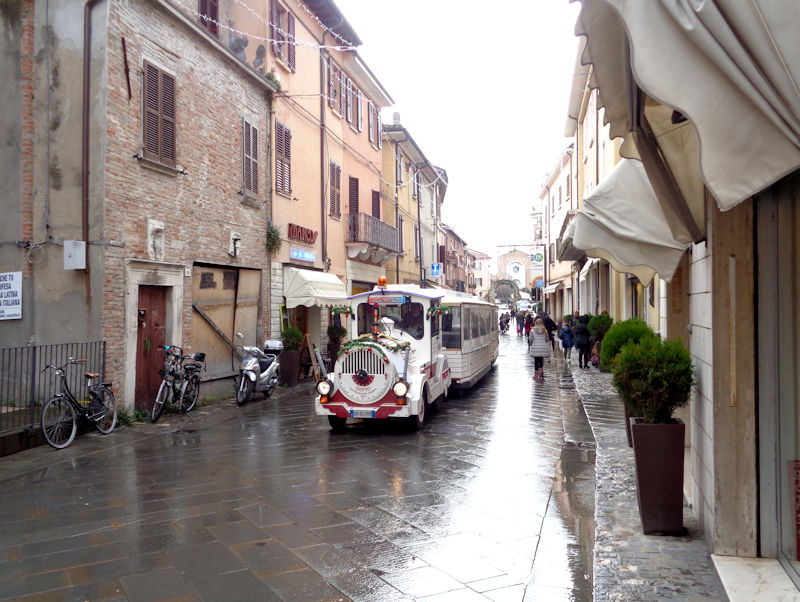
Another Dotto tourist road train (the company Trenini di Rimini evidently has quite a few trains).
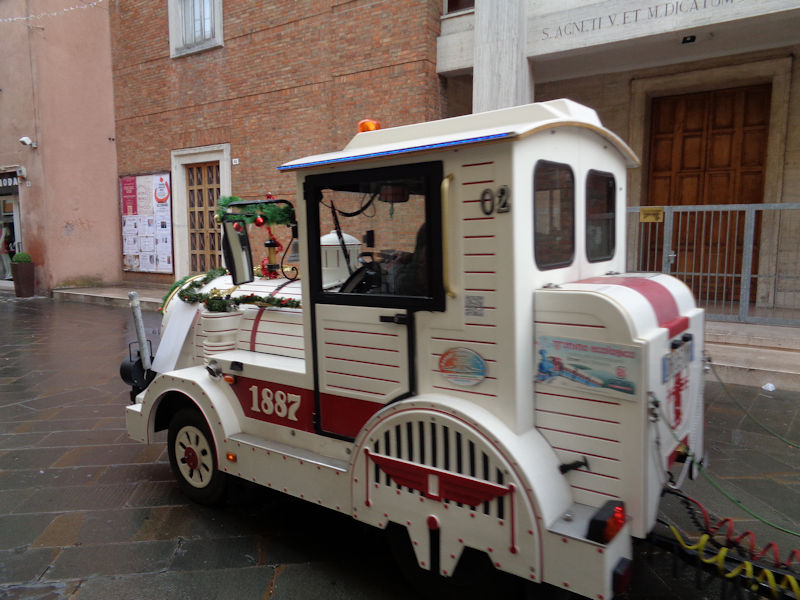
This one is the Dotto 1887 model. (The most common model of Dotto road train is the 'Muson River 1894', named for a mostly dry old creek that runs by the headquarters in Castelfranco Veneto.)

This is the Corso Giuseppe Garibaldi, a continuation of the cardo maximus southwest toward . . .

. . . the Porta Montanara. The gateway here, built during the Roman civil wars of Marius and Sulla, was functional to the 1940s but was destroyed in the weeklong Battle of Rimini in September 1944, when Canadian, New Zealand, and Greek troops drove the Germans out of Rimini. This surviving arch was found absorbed into undamaged nearby buildings and reconstructed downtown, but in 2003 it was painstakingly relocated in its original place.

We've been wandering a bit but now we're coming up on what turns out to be the back end of the Antica (or Vecchia) Pescheria, the old fish market, built in 1747 facing out onto the large Piazza Cavour.
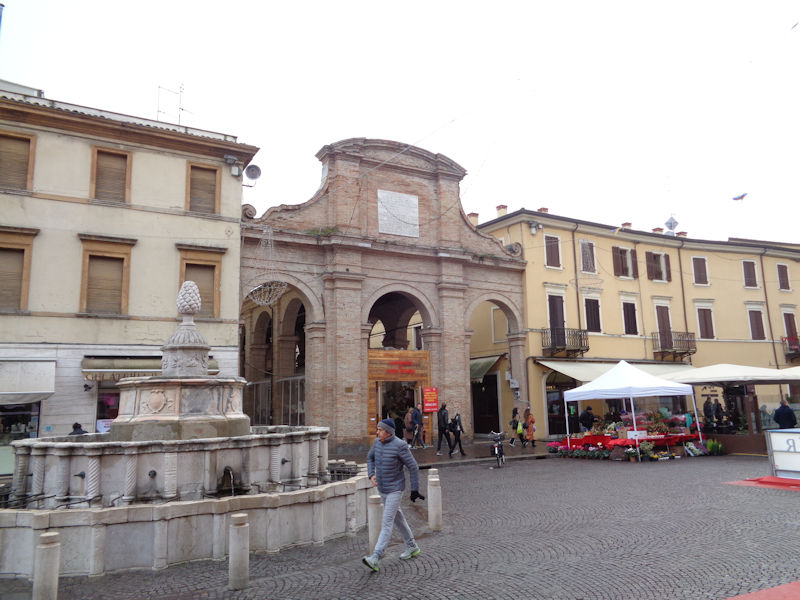
The façade of the Antica Pescheria facing out onto the piazza, with the Fontana della Pigna on the left.
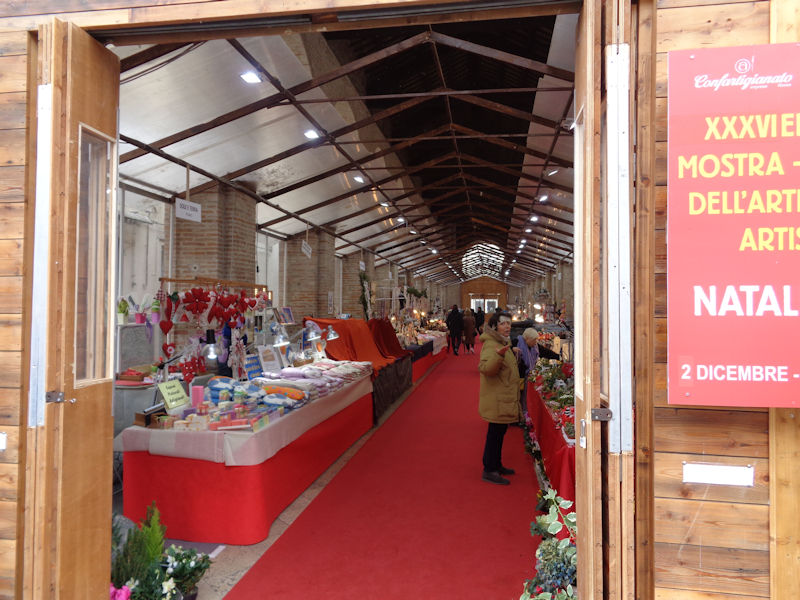
The inside of the Old Fish Market -- it appears to function as a legitimate hang-out for festive young people during most of the year, with pubs and discos nearby, but transforms itself into a Christmas Market in season.

The Piazza Cavour, one of the two main squares of Rimini -- the Piazza Tre Martiri is older and larger, but the Piazza Cavour has the chief medieval government buildings. The Palazzo Grampi, part of the city hall, is behind the fountain. The Pinecone Fountain was in Roman times the main or only source of water, but the present fountain was built in 1543 after in 1540 some festive fireworks in honor of the future Pope Julius III misfired and blew the old one up.
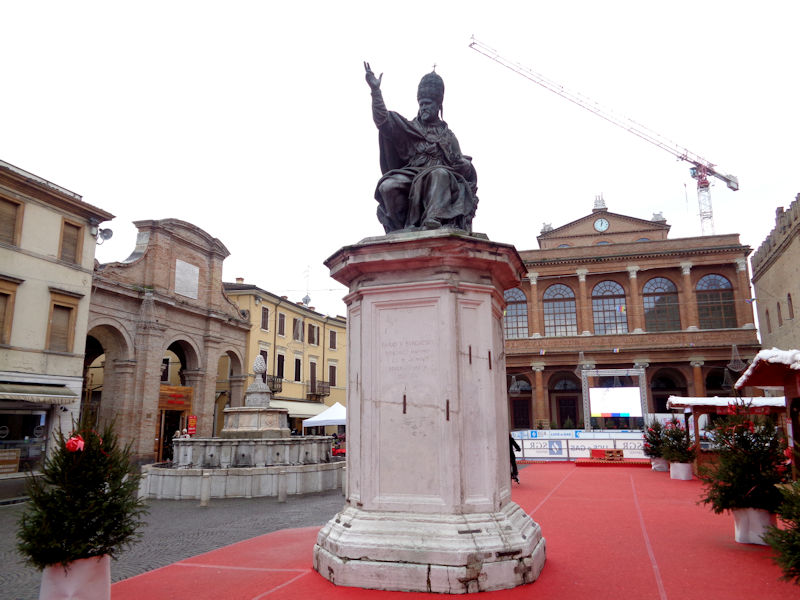
The statue, built in 1613, commemorates Pope Paul V, who financed the replacement Fontana della Pigna in 1541. (Rimini was a Papal State at the time.)
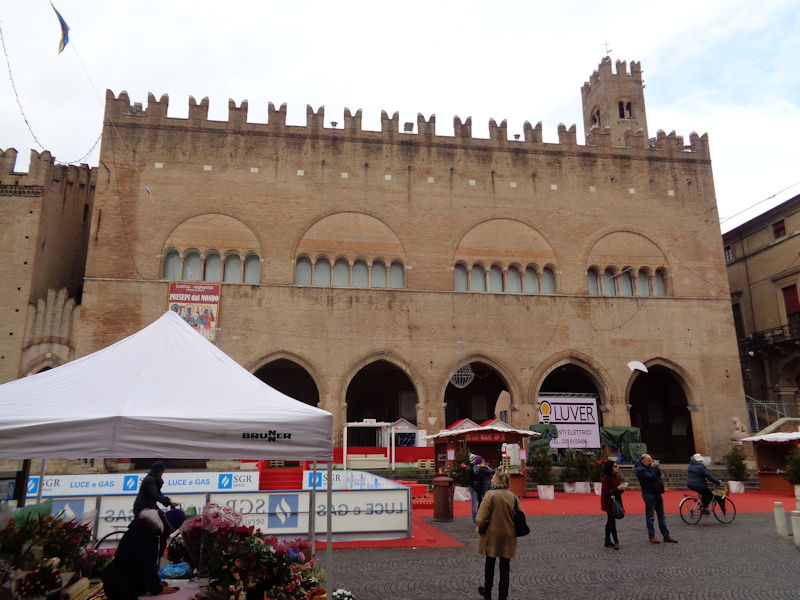
Across the square from the Old Fish Market is the Palazzo dell'Arengo, built evidently in 1204 to house the oligarchic civic assembly (called the Arengo, as in San Marino), and renovated in the early 20th century.
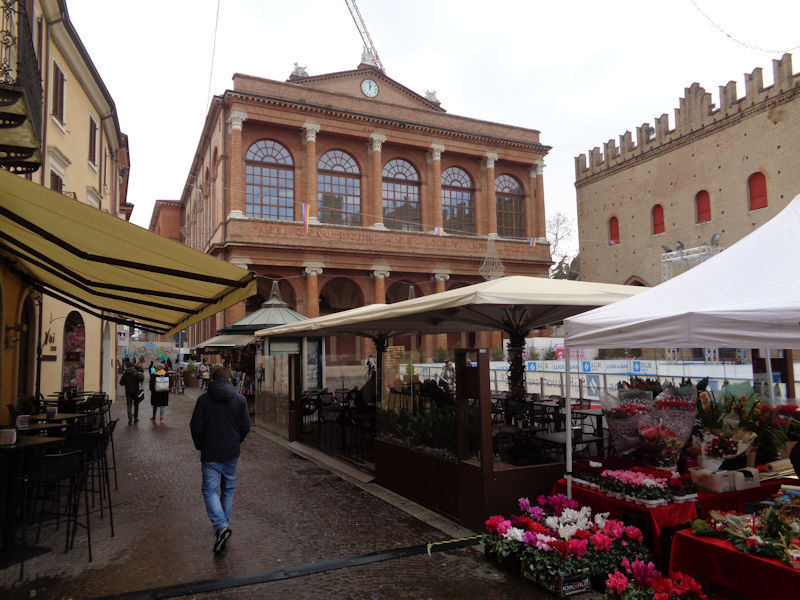
At one end of the Piazza Cavour is the Teatro Galli, inaugurated in 1857 with the premier of Verdi's L'Aroldo, directed by himself, but 90% destroyed by Allied bombing in 1944. Reconstruction respecting the original designs was begun in 2014 and appears as of now to be proceeding well, at least from this angle.

Adjacent to the Palazzo Arengo is the Palazzo del Podestà, built in 1334 to accommodate the administration and residence of the podestà, the medieval official hired from outside the city (thus free of local conflicts of interest) to administer the city for a fixed term. The crenellations of all three civic buildings were apparently added in the 1920s.

The obligatory Christmas-season temporary skating rink
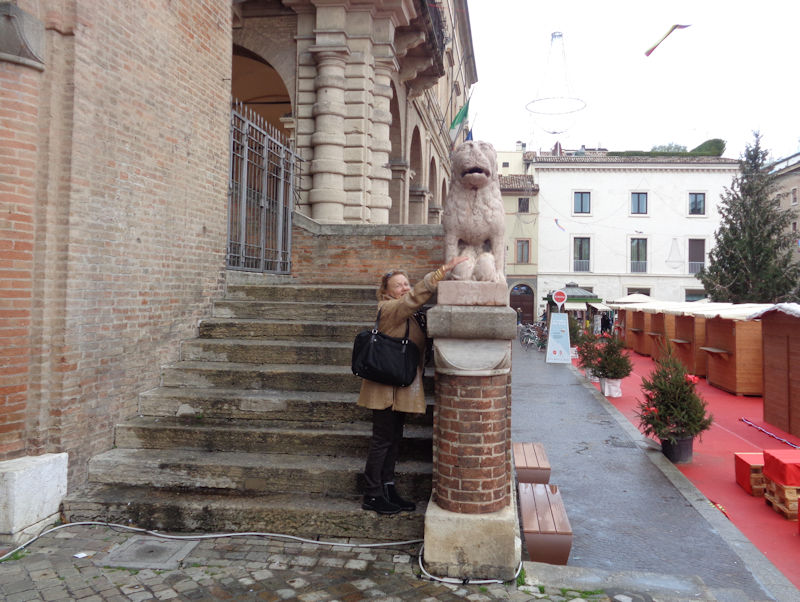
We have a growing collection of photos of Kristin with her hand in the lion's mouth, but this one can't join the others.
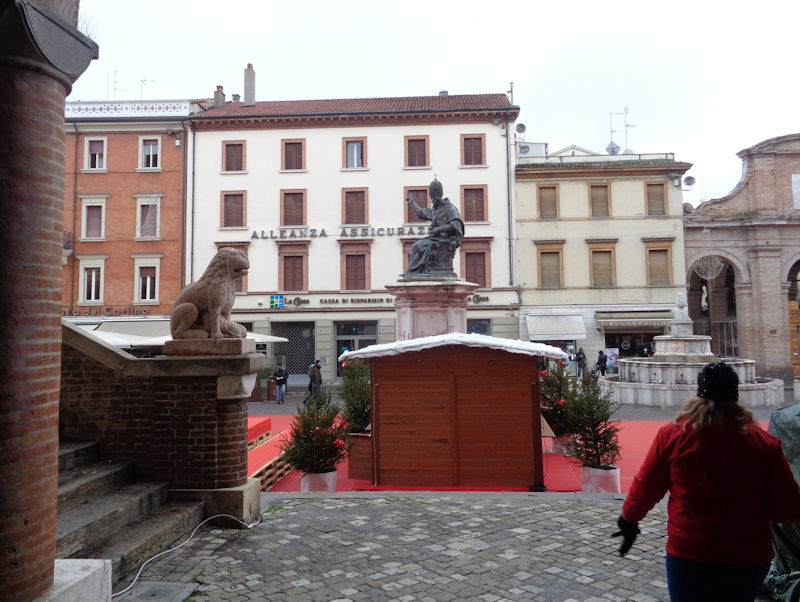
Pope Paul V and the lion

This is the Ponte di Tiberio, the Tiberius Bridge, begun by the Emperor Augustus in about AD 14 and completed by his successor Tiberius in 20. It connects the Roman road the Via Flaminia (220 BC) from Rome, which entered Ariminum at the Arch of Augustus at the far end of the decumanus maximus through town, to the Via Aemilia (187 BC) which continued northwest up the Po valley to Piacenza and to the Via Popilia (132 BC), which continues to Ravenna, past the Venetian area, as far as what was then the huge Roman town of Aquileia near the Isonzo river by the Slovenian border.
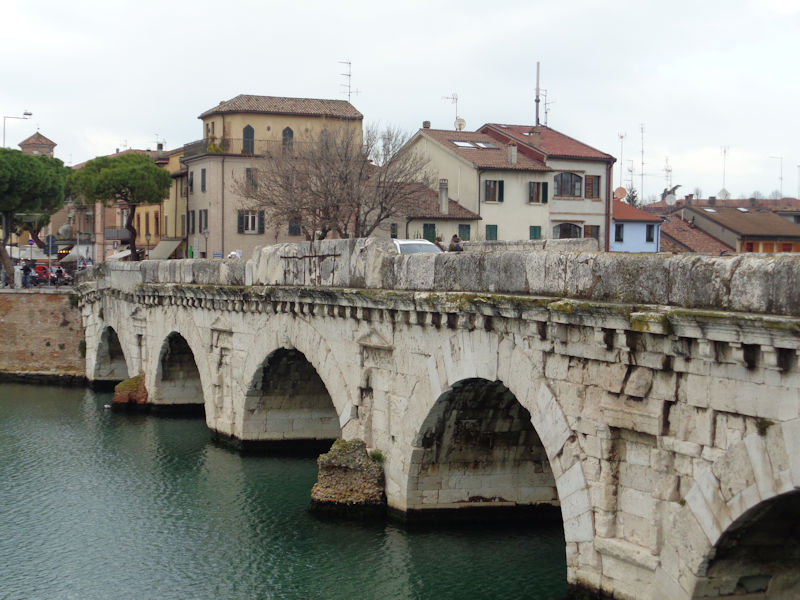
Numerous attempts have been made to destroy the bridge over the centuries, most notably by the Byzantine General Narses in AD 551 and most recently by the fleeing German army in AD 1944, but all of them failed.

The bridge spans the Ausa creek part of the river Marecchia, which flows down from the Apennine province of Arezzo to the Adriatic Sea 2km downstream from here, but . . .
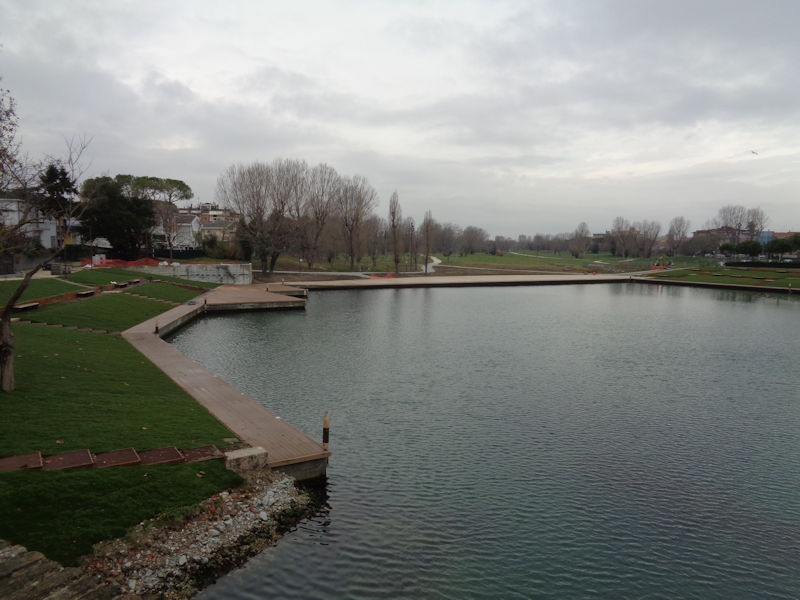
. . . the part above the bridge has been turned into a closed basin and city park.

What Narses and the Wehrmacht couldn't do, modern traffic might still accomplish -- though heavy vehicles are banned.

This, alongside a rather rude church, is the Museo della Città, presently closed until well into the crepuscular hours, but we will come back in a day or two to follow up.

The Chiesa Cattolica Suffragio, built by the Jesuit order in 1721, now also called the church of San Francesco Saverio -- it's obviously incomplete, though Jesuits and Franciscans seem to have preferred things that way. The Jesuit order was suppressed in Italy by the pope in 1773. The Jesuit convent alongside became a hospital for a time but is now the City Museum.

Next door to that, this is the Domus del Chirurgo or Surgeon's House, a well-turned-out excavation of a Roman house -- also closed for a long lunch, but we'll come back to visit it in a few days.

Speaking of lunch, it's time to try out the Magna Grecia ristorante Greco. A good choice, as it turns out.
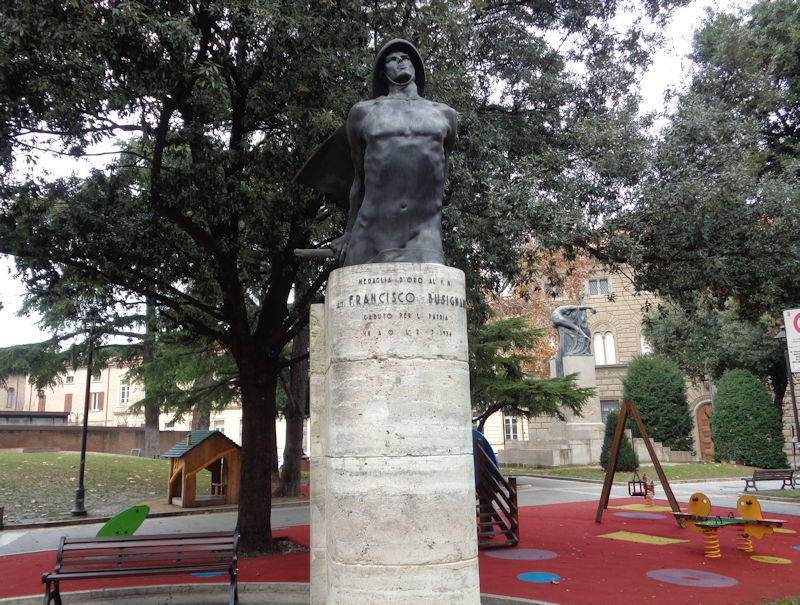
Here, next to the Surgeon's House, is a war memoral to a fallen hero, who was awarded the Medal of Gold -- he was Fallen for the Fatherland (caduto per l'patria) in 1936, bringing muscular Italian civilization to the Ethiopians.

Most of Rimini's war damage has been expertly repaired or replaced, but not all of it.
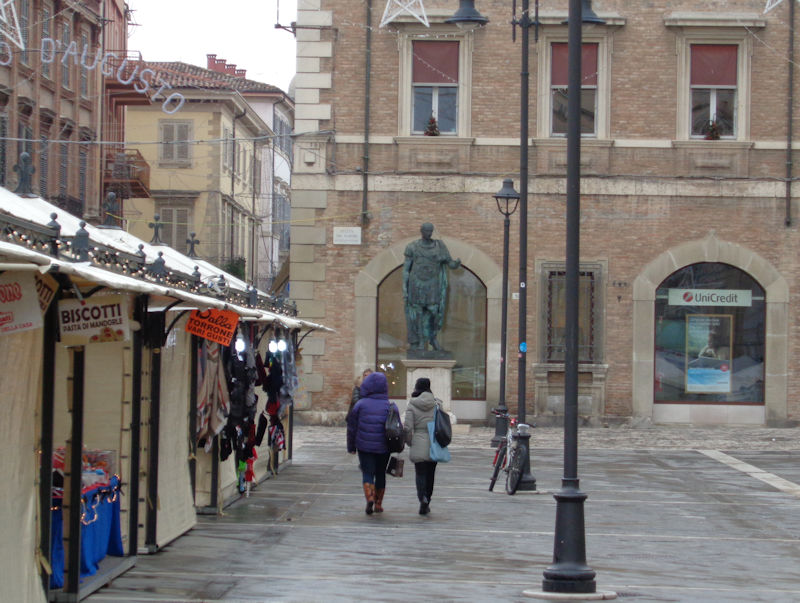
A statue of Julius Caesar in the Piazza Tre Martiri

Yum. Incredible Holland Chips.

The Corso d'Augusto, leading to the Emperor Augustus' Arch at the old city gate

Here, at the far end of town from the Tiberius Bridge, is the Arco di Augusto or Emperor Augustus' Arch, built in 27 BC, it's said, to mark the termination of the Via Flaminia and provide a gateway to the city, though the arch is evidently too big ever to have functioned as a closed gate. The battlements on top date from medieval times.

A very big arch. It functioned as a city gate until the Fascists knocked the city walls down and left this as a museum piece.

That cute little Volvo in the carpark is already spoken for. We're looking for the Castel Sismondo, a.k.a. the Rocca Malatestiana, and it ought to be around here someplace.

Ah, it's a work in progress. The future of Rimini depends upon its ancient heart, so your taxpayer euros will be well spent. It's true.

In the Piazza Malatesta we can get a fine view of the progress of the work and the chain link fence. The castle was built by Sigismondo Pandolfo Malatesta from 1437 to about 1452, with some help from Brunelleschi early on, and was designed with walls capable of resisting the recent advances in artillery. There was a moat, outer walls, and a ravelin as well, now gone, but the central part also served as a residence for the Malatesta family. It will be noticed that the defensive towers are all on the side facing into the city rather than out into the countryside.
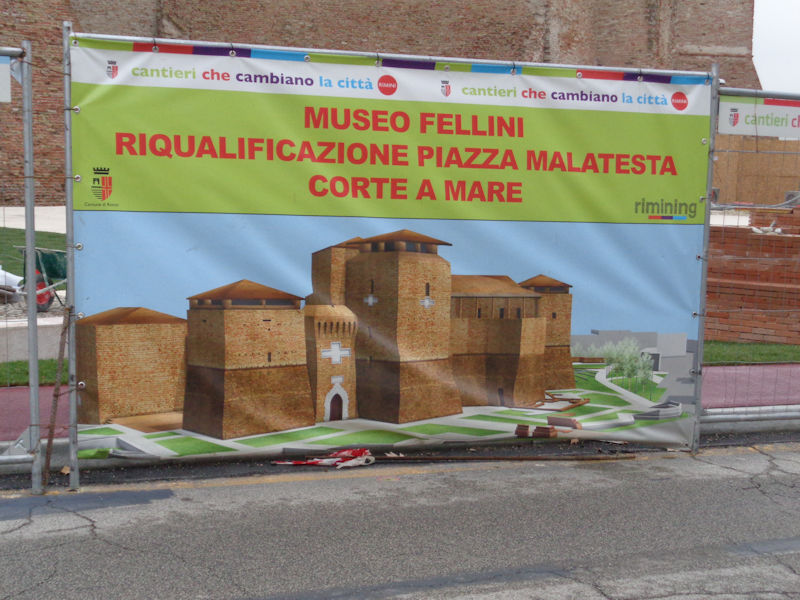
The new complex will include a museum for the film director Federico Fellini, who was born in Rimini. There are evidently going to be exhibition halls and a convention centre as part of the project.
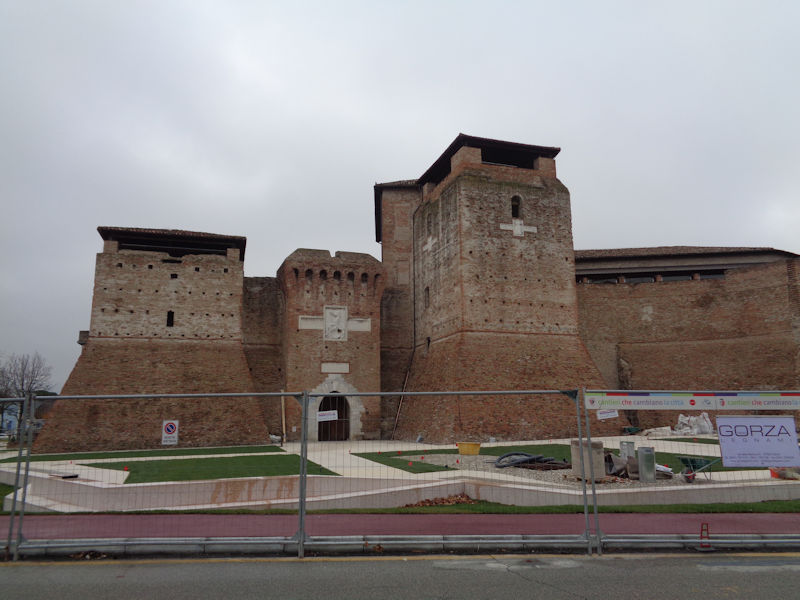
We'll have to come back someday.

And here, on the far side of the Piazza Malatesta, is the back end of the Teatro Galli, which from the front in the Piazza Cavour looked almost finished.
Tomorrow: The walled hilltop town of Gradara

 Dwight Peck's personal website
Dwight Peck's personal website











































































